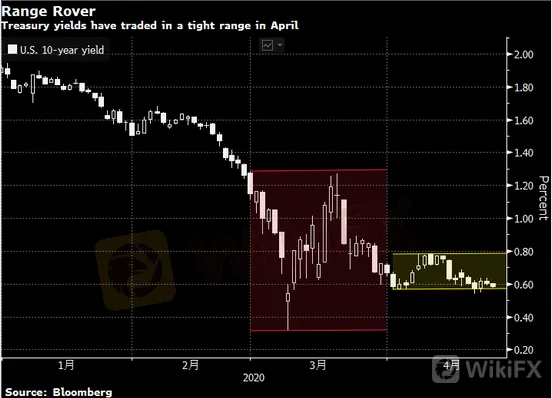简体中文
繁體中文
English
Pусский
日本語
ภาษาไทย
Tiếng Việt
Bahasa Indonesia
Español
हिन्दी
Filippiiniläinen
Français
Deutsch
Português
Türkçe
한국어
العربية
Whether United States Escapes Deflation Will Affect Treasury Bond Market
Abstract:Unlike the violent fluctuation in the energy market and the great volatility in the stock market, the U.S. Treasury market has been particularly calm in recent weeks, and no one can say where it's heading to.
Unlike the violent fluctuation in the energy market and the great volatility in the stock market, the U.S. Treasury market has been particularly calm in recent weeks, and no one can say where it's heading to.
After the initial shock of the coronavirus epidemic, many bond traders were neither able nor willing to bet on the direction of US Treasury yields. The benchmark U.S. 10-year Treasury yields, after roller-coastering in March from a record low of 0.31% to a high of 1.27%, fluctuated in a much smaller range of 0.54% to 0.78% in April.
According to the institutional investor survey data released by JP Morgan Chase, two-thirds of the surveyed institutions have become more neutral in terms of fund allocation, a proportion close to the highest level in the past two years. This situation indicates that there are few large-scale risk-taking investments at the moment.
Most bond yields have been trading in a tight range, which means that investors are still holding out to see whether the United States can escape the whirlpool of deflation. A large amount of fixed-income futures positions were closed in March, and since then, the size of the open interest has hardly changed, and has been hovering around the lowest level since 2017.

Disclaimer:
The views in this article only represent the author's personal views, and do not constitute investment advice on this platform. This platform does not guarantee the accuracy, completeness and timeliness of the information in the article, and will not be liable for any loss caused by the use of or reliance on the information in the article.
WikiFX Broker
Latest News
Why is there so much exposure against PrimeX Capital?
Russia to Fully Ban Crypto Mining in 10 Regions Starting January 1, 2025
Two Californians Indicted for $22 Million Crypto and NFT Fraud
Macro Markets: Is It Worth Your Investment?
WikiFX Review: Is Ultima Markets Legit?
Colorado Duo Accused of $8M Investment Fraud Scheme
What Impact Does Japan’s Positive Output Gap Have on the Yen?
RM62k Lost Investment Scam After Joining XRP Community Malaysia on Telegram
Victims of Financial Fraud in France Suffer Annual Losses of at Least €500 Million
Malaysia Pioneers Zakat Payments with Cryptocurrencies
Currency Calculator


